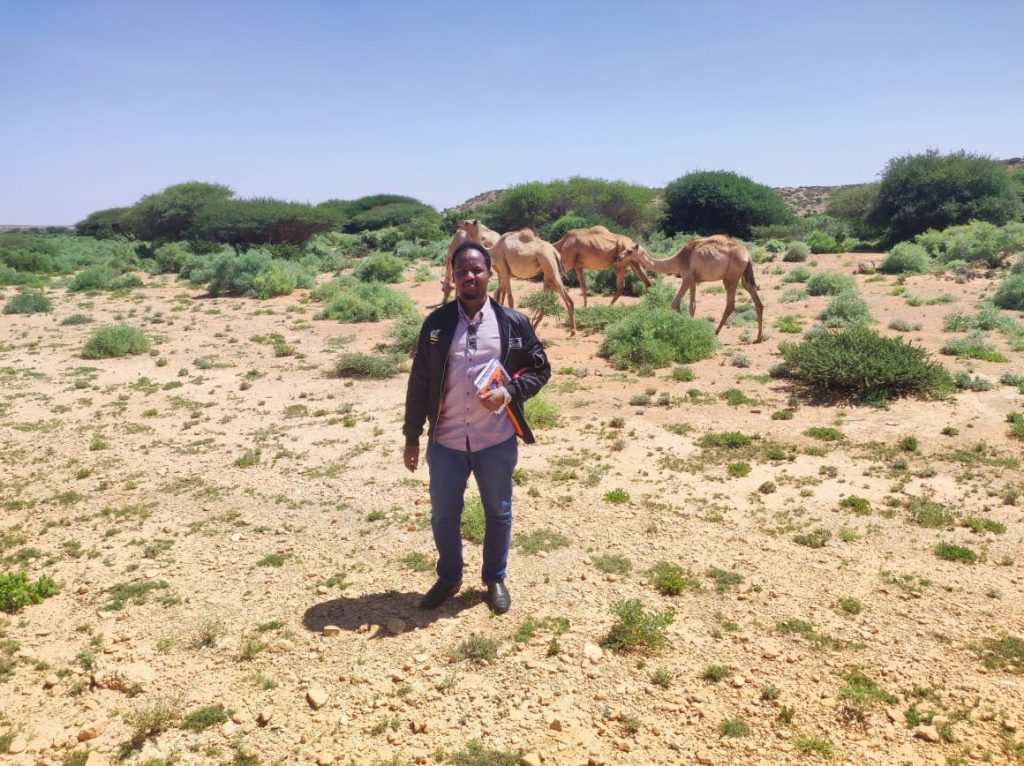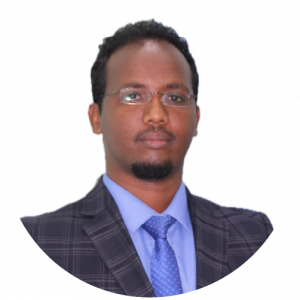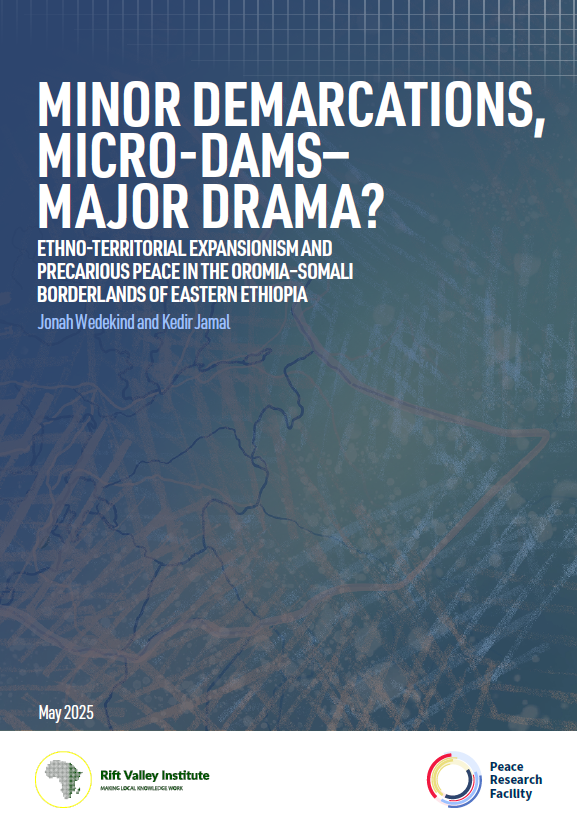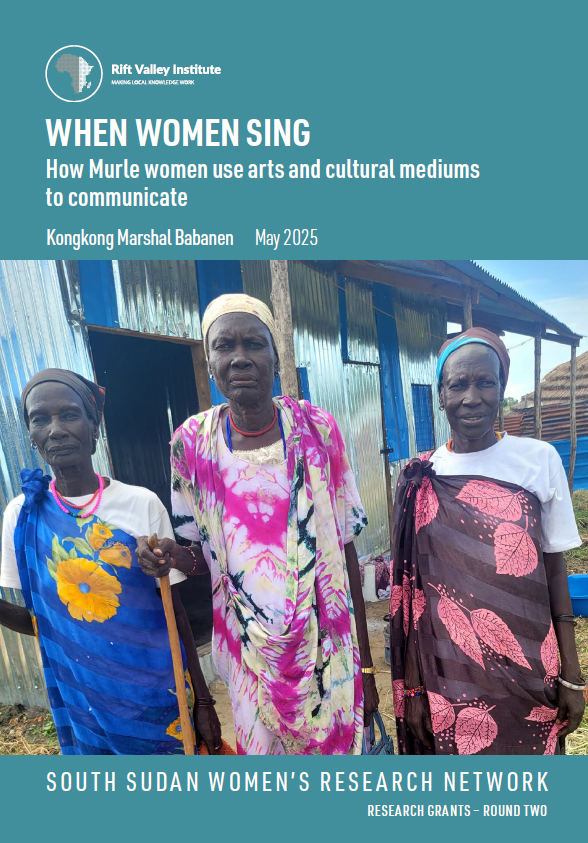In this blog, Abdirzak Mursal Mohamed examines the nexus between climate change impacts and land conflicts among pastoral communities in Saaxmaygaag, Puntland.
By Abdirizak Mursal Mohamed

Introduction
This blog examines the nexus between climate change impacts and land conflicts among pastoral communities in the Saaxmaygaag area of Puntland, northeastern Somalia. With climate change, competition between communities—and countries—for scarce resources, especially water, is increasing, exacerbating old dilemmas and creating new ones. Environmental refugees are reshaping the human geography of the planet, a trend that will only increase as deserts advance, forests are felled and sea levels rise. Mega crises may well become the new normal. These are all threats to human security, as well as to international peace and security.[1]
In Somalia, there is already evidence of the manifestation of climate change, seen in increasing temperatures and rainfall variability that include unpredictable extreme weather events, such as drought and floods. Drylands occupy 41 per cent of the earth’s surface, 45 per cent of it given over to agriculture.[2] Loss of income from agriculture and from pastoralism can heighten the risk of violent conflict or push people into armed groups when people find their livelihood security threatened.
Puntland, a Federal Member State of Somalia, was established on 1 August 1998. The majority of its population depends on farming, fishing, producing frankincense or raising cattle—all hit by the impact of climate change. This has resulted in confrontations, such as that at the border of Nugaal and Sool regions, which has its root causes in land claims and in subsequent attempts at urbanization by sub-clans.[3]
Between 2019 and early 2023, climate change brought four consecutive seasons of drought to Somalia. During dry seasons, communities used to harvest rainwater from catchment pods they had dug, but these dried up—and were anyway dangerous, as people and livestock fell into them. In some places, such as in Haji Khair in Puntland in 2021, people were prone to displacement due to lack of water.
Although climate change is considered a grave human security concern, the literature available fails to capture key issues.[4] It shows the frequency and effects of famine over the past 30 years to be unprecedented in Somalia. However, the literature falls short of explaining why food insecurity and drought—not uncommon across the the broader Horn of Africa—quickly deteriorate into famine in Somalia but not necessarily in neighbouring countries.
This blog argues that the protracted armed conflicts in Somalia and the dynamics they generated have fuelled recurrent famine. Famine and its outcomes further sustain conflict, creating a conflict–famine nexus. The research behind the blog applies analytical tools—state-collapse, displacement, poverty and environmental degradation—to highlight the overlap between conflict and famine. Puntland has judicial, legislative and executive branches of government, including a presidency, but the research demonstrates that Saaxmaygaag’s protracted conflict and recurring famines emanate from the missing role of the state. Therefore, a durable solution to famine (and other underlying factors threatening communal resilience to external shocks) will require a compelling, legitimate and functioning state.[5]
Climate change experiences
Members of a Focus Group Discussion, held with pastoralists, confirmed their experiences with recent drought, as well as the coping mechanisms they had. Participants reported experiencing a severe drought between 2019 and early 2023 that had significantly impacted their lives and livelihoods. They listed some of its negative effects, including extreme food insecurity and hunger; severe challenges, both to humans and animals, due to water scarcity; the forced relocation of rural communities to other parts of Puntland (for survival); a shortage of pasture, due to land degradation; and poor sanitation and hygiene (as a result of limited water). Their coping strategies included buying maize to supplement animal food, searching for water in isolated areas and purchasing food items to ensure their survival.
The terrible effects of recent droughts were made clear. Their way of life and means of subsistence were severely damaged. They recognized a connection between land conflicts and drought, emphasizing the necessity for long-term solutions for resource shortages and conflict resolution. A technical adviser from the Puntland’s Ministry of Environment and Climate Change confirmed there had been adverse impacts to the numbers of livestock, which he described as the primary economic resource for ‘60 per cent of Puntland’s population’. He emphasized that drought-induced resource scarcity led to increased mobility and competition for land and water, ultimately triggering resource-based conflicts.[6]
Relationship between climate change impacts and land conflicts in Puntland
Pastoral communities in Saaxmaygaag revealed the presence of ongoing land conflicts, primarily driven by resource scarcity. One respondent reported a two-year long conflict (2021–2023) between two clans over land access. Respondents identified the detrimental consequences of land conflicts to include ‘loss of life and injuries, property disputes, land displacement, economic losses and loss of pastureland’. Participants shared harrowing accounts of being evicted from their homes, enduring inter-clan conflicts and grappling with famine. These experiences underscore the urgent need for interventions that address the root causes of land disputes and climate-induced displacement.
These results are consistent with the literature showing that areas with relatively better rainfall have attracted a high concentration of human and livestock populations, worsening land degradation due to overgrazing. The longer these populations remained in an area, the more severe their impact on grazing land. Respondents described the deforestation of pasture and rangeland; the long distances—often of 40 to 50 km—travelled to find water; increased thirst, caused by high temperatures; and flooding, due to inadequate infrastructure.
They said the three-year-long, inter-clan conflict had resulted in 30 to 50 deaths. Most recounted being forcibly relocated from their homes, losing possessions and suffering from famine. When asked about incentives to return to their home areas, they emphasized the need for ‘peace and reconciliation programs, community interaction initiatives and maintaining pasture fields free of settlements’. When queried about coping mechanisms, respondents reported two primary strategies: Seeking water from distant locations and constructing rudimentary water catchment systems, known as berkets.
When asked about solutions to land conflicts, participants emphasized government interventions, such as banningillegal land tenure (where armed groups or individuals illegally acquire and enclose grassland), establishing conflict resolution mechanisms, penalizing conflict perpetrators and enforcing existing land regulations. There was agreement on the potential effectiveness of government action by Puntland in resolving land disputes. A technical adviser from the Ministry of Interior, Federal Affairs and Democratization, suggested:
In Saaxmaygaag, preventing land conflicts requires a multi-pronged approach: Firstly, the government must play an active role, facilitating talks and mediations before tensions boil over. Accessible courts and transparent legal frameworks should be established to resolve disputes fairly and land regulations need revising to guarantee clarity, equitable access and sustainable practices. Secondly, local residents should be trained to identify brewing conflicts and to trigger timely interventions. Thirdly, respected community leaders can facilitate respectful dialogue and culturally relevant solutions. Fourthly, psychological support and restorative justice initiatives help communities heal from past grievances and rebuild trust. Finally, peacebuilding principles and conflict resolution skills—integrated into school curricula and community awareness programs—can equip future generations tprevent land conflicts from taking root.
Conclusion
This blog concludes that climate change may influence the frequency and intensity of land conflicts in Saaxmaygaag in Puntland, Somalia. Insufficient drought response, due to land conflict, hinders aid reaching vulnerable populations, resulting in casualties, property disputes and economic and environmental loss. The blog recommends the Puntland government restrict illegal land ownership practices, establish mechanisms for resolving land disputes, hold the perpetrators of land conflict accountable through legal measures, enforce existing land regulations, foster peacebuilding initiatives and community engagement, and protect pastureland by restricting settlement. In addition, local authorities in Saaxmaygaag need to collaborate with local communities to diversify local water sources, instead of relying on rainfall and catchment areas. Additional measures could include drilling boreholes, installing solar-powered wells and encouraging a gradual shift towards an agro-pastoral livelihood.
Overall, the blog emphasizes the need for a multifaceted approach to address the impact of climate change in Saaxmaygaag, encompassing legal and social interventions, sustainable resource management practices, the diversification of water sources and livelihoods, and the strengthening of both warning and response systems. The researcher recommends that the Puntland administration and the local authorities in Saaxmaygaag discourage—and penalize—individuals who ignite or perpetuate conflict.
[1] Caroline Sofie de Groot, ‘Security risks of climate change: Climate change induced conflicts in western Kenya,’ Bachelor thesis, Uppsala University, Uppsala, 2018.
[2] Dorothy Amwata and Snelder, ‘The influence of water resources on pastoral and agropastoral households’ food security in Kajiado District, Kenya’, Research Journal of Agriculture 8/9 (2021): 1-14.
[3] Puntland Development and Research Center, ‘Saaxmaygaag–Sangejabiye: Reconciliation Efforts’, Report, 5 July 2022. Accessed 18 April 2024, https://pdrcsomalia.org/wp-content/uploads/2019/09/Reconciliation-Efforts_Report.pdf
[4] Shazia Chaudhry, ‘Climate change and human security in Africa: A case study of the Mau forest complex, 1963-2012,’ Masters thesis, University of Nairobi, Nairobi, 2014.
[5] Heritage Institute for Policy Studies, ‘Climate change and conflict in the Horn: Challenges, responses, and new mandate,’ Heritage Forum, September 2023. Accessed 18 February 2024, https://8v90f1.p3cdn1.secureserver.net/wp-content/uploads/2023/09/Climate-Change-Conference-Proceedings-28-Sep.pdf
[6] Heritage Institute for Policy Studies, ‘Climate change and conflict in the Horn’.
About the author
Abdirizak Mursal Mohamed holds a Master of Arts in Environment, Development and Peace from the United Nations University of Peace, Cost Rica, a Master of Arts in Public Administration from Islamic University, Uganda and a Bachelors Degree in Social Science from the University of Bosaso in Somalia. Abdirizak currently serves as environmental governance adviser to the Ministry of environment and Climate change in Somalia.
Acknowledgements
This blog has been produced as a result of Abdirazak’s training in the Rift Valley Institute’s (RVI) Research Communities of Practice (RCoP) project. The blog therefore reflects the views of the author and not those or the position of the Rift Valley Institute. The RCoP is one of the RVI’s flagship projects that supports the professional development of early career scholars in east and central Africa through training, mentorship and dissemination of research outputs. Building on RVI’s long-term experience and presence in the region, the RCoP is a value-driven project that is built around a community of practitioners and academics with a common interest in the professional development of early career researchers. With funding from the Carnegie Corporation in New York, USA, and in partnership with the Open Society University Network-Hub for Connected Learning Initiatives, the RVI trained 27 early career scholars from Somalia, Somaliland, Ethiopia, the Democratic Republic of Congo (DRC), South Sudan and Kakuma refugee camp in Kenya in the first and second phases of the RCoP project between August 2022 and January 2024.
This blog was edited by Catherine Rosemary Bond.



